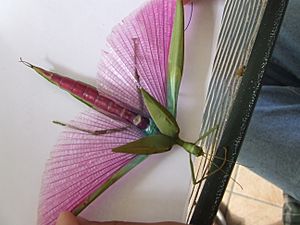Pink-winged phasma facts for kids
Quick facts for kids Pink-winged phasmaPodacanthus typhon |
|
|---|---|
 |
|
| The pink-winged phasma showing its beautiful wings | |
| Scientific classification | |
| Kingdom: | |
| Phylum: | |
| Class: | |
| Order: | |
| Family: | |
| Genus: |
Podacanthus
|
| Species: |
P. typhon
|
| Binomial name | |
| Podacanthus typhon Gray, (1835)
|
|
The pink-winged phasma (Podacanthus typhon) is a special type of stick insect found only in Australia. It gets its name from its amazing pink wings, which are usually hidden but can be seen when it flies or feels threatened. This insect is a master of disguise, blending in with its surroundings like many other stick insects.
Contents
Where It Lives: Range and Habitat
This unique stick insect is found only in Australia. When an animal or plant is found only in one specific place, it is called endemic. The pink-winged phasma lives along the South-East coast of Australia. You can find it in the Murray-Darling basin, which is a large river system area in New South Wales. It usually lives in trees and bushes, where it can easily hide among the leaves and branches.
What It Looks Like: Identification
The pink-winged phasma is a medium-sized stick insect. It can grow to about 110 mm long, which is about the length of a typical smartphone. Its body is usually a brownish or greenish color, helping it to blend in with plants.
Body Features
The middle part of its body, called the mesothorax, is smaller than other parts. It has tiny spines on it. The large, beautiful wings are attached to this mesothorax. Underneath its body, there are more small spines on its chest and belly. Its legs are a reddish-pink color, matching its wings.
Wings and Coloration
The most striking feature of this phasma is its wings. While the outer wings are often dull to help with camouflage, the inner wings are a bright pink! These colorful wings are usually folded up and hidden. When the insect is disturbed or needs to fly, it flashes these pink wings. This sudden flash of color can surprise a predator, giving the phasma a chance to escape.
Size Comparison
Compared to some other stick insects, the pink-winged phasma is not huge. For example, it is much smaller than the giant titan stick insect. However, it is similar in size to the children's stick insect, another well-known species.
Life Cycle and Behavior
Like all insects, the pink-winged phasma goes through different stages in its life. It starts as an egg, hatches into a nymph, and then grows into an adult.
Diet and Camouflage
Pink-winged phasmas are herbivores, meaning they eat plants. They mostly feed on the leaves of various trees and shrubs. Their amazing camouflage helps them stay safe from predators like birds and lizards. They can stay perfectly still for a long time, looking just like a twig or a leaf.
Reproduction
Female pink-winged phasmas lay eggs, often dropping them to the ground. The eggs are designed to look like plant seeds, which helps them avoid being eaten by predators. After a period of time, tiny nymphs hatch from these eggs. These nymphs look like miniature versions of the adults and will grow by shedding their skin several times.

